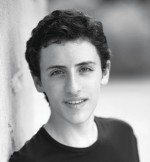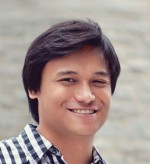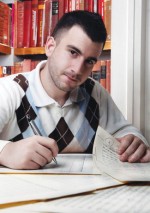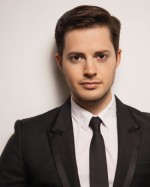Title
Subhead
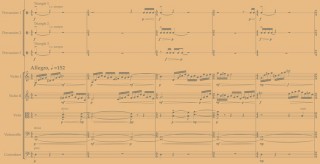
Joshua Cerdenia's Magayon is one of four works to be premiered by Jeffrey Milarsky and the Juilliard Orchestra.
Each year, Juilliard composition students submit works to be considered for performance by the Juilliard Orchestra. This year’s competition winners are Chason Goldfinger, Joshua Cerdenia, Michael Seltenreich, and Aaron Severini. Their pieces will be conducted by Jeffrey Milarsky.
Body
American history buffs will recognize the hometown of the program’s first composer, Chason Goldfinger, who hails from Valley Forge, Pa., where George Washington’s Continental Army spent the brutal winter of 1777-78 and where almost 2,500 soldiers died of disease and exposure. Goldfinger’s elegiac Ghosts of Iron, Memories of Stone recalls the atmosphere of Valley Forge National Historical Park, where Goldfinger often hiked as a youth. The 10-minute piece, with an opening marked “Serene, like a forest at dawn,” evokes the ambient sounds of nature via an offstage ensemble whose members are positioned throughout the hall. Among other things, the scattered wind instruments play aleatoric birdcall figures, and one of the percussionists plays an anvil, evoking the iron forge for which the area is named. A winter storm develops, and the middle portion of the piece, “Like a defeated army in retreat,” gives way to reflective, emotional strings, which gain confidence on their way to the climax, “Grandeur of the mountaintop.” Goldfinger, a sophomore, studies with Robert Beaser through the Barnard-Columbia-Juilliard exchange program; at Columbia, he studies neuroscience.
The concept of home also figures prominently in the second piece on the program, first-year master’s composer Joshua Cerdenia Pangilinan’s Magayon. He was born in the Bicol Region of the Philippines and grew up in Manila; he studied at Singapore's Yong Siew Toh Conservatory of Music and Peabody. Lamenting the lack of opportunities for a classical composer back home, he said that he wants “to have something Filipino to contribute to the music scene wherever I go.” Magayon, which in Bicolano means “beautiful,” is the name of a goddess from Filipino mythology. Cerdenia uses the dramatic outline of the myth, in which a jealous rival wreaks havoc in the midst of preparations for Magayon’s wedding, as the backbone of his three-section piece. It opens in a festive mood with a zipping theme quickly trading off between the first and second violins. The mood turns sinister with chromatic variations on that same theme beginning in the low strings followed by a lamentoso section that concludes with an air-clearing trombone solo. The piece concludes with a loud, allegro finale filled with brass. This is the second piece that Cerdenia, who’s studying with Christopher Rouse, has written for orchestra.
The program also includes first-year master’s student Michael Seltenreich’s ARCHETYPE, for which Seltenreich was awarded this year's Arthur Friedman Prize (a prize awarded for the score "deemed most outstanding" by the competition's judges). Born in Tel Aviv, he began taking composition lessons at 10 and studies here with Matthias Pintscher. The concept for Seltenreich’s piece comes from Carl Jung’s theory of archetypes—a corpus of unconscious models that throughout history universally manifest themselves in the collective thoughts and behavior of various cultures. Interpreted musically, a theme could be considered a kind of archetype, and its variations and mutations its manifestations. In this way, ARCHETYPE is a theme-and-variations piece. But since they’re unconscious, Jung’s specific archetypes are by nature mysteries—and as a result, Seltenreich struggled with whether to keep secret the original theme upon which each of ARCHETYPE's variations is based. Ultimately, though, he decided to reveal the theme in a violin solo at the end of the work. Seltenreich calls Dutilleux, Boulez, and Messiaen his “bread and water” and the aesthetic of the piece is duly French-inspired, he said. And while it’s mostly atonal, the sonority is lush and warm. “Harmony and the relationships between one chord and another are very important to me,” he said.
Closing the program is Aaron Severini’s Sleet. Severini, who grew up in Greenfield, Mass., spent more than a decade dancing at the New York City Ballet before switching gears entirely—he’s now a fourth-year undergraduate who studies with Christopher Rouse. Sleet is dance-like, jittery, and contagiously electric—it’s easy to imagine accompanying choreography. Driving, propulsive lines are freely exchanged between strings, winds, brass, and percussion, comprising a thorough tour of the orchestra. Severini demonstrates nuanced understanding of instruments and players in this, his first piece for full orchestra. “I write as if I’m writing entrances and exits for dancers,” Severini admits. He asks himself questions like, “How tired are they right now? Do they need a break? Do I need to switch to or from brass or winds or strings?” The score includes specific notes for several interesting effects. For instance, in one section, he asks that the bass drums and double basses be tuned to the lowest frequencies possible and, with four percussionists occupied, he has the pianist depress the damper pedal while striking near the piano’s soundboard with a fluffy bass drum beater.

